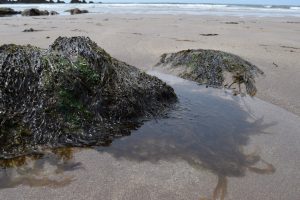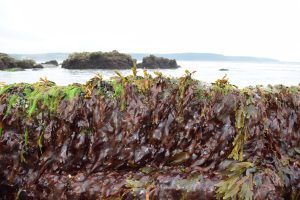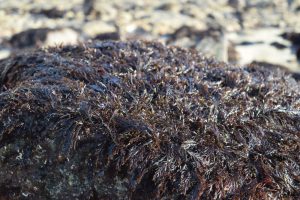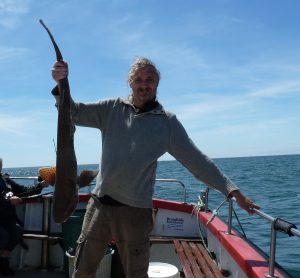Email: geoffdann@hotmail.com
Phone: 07964 569715
11/07/2016
I’ve just returned from a week’s holiday in Pembrokeshire, much of which I spent wandering about near-deserted beaches at low tide in search of seaweed – specifically in search of really nice photos of edible seaweeds. Pembrokeshire is, of course, famous for one particular edible seaweed that is an essential traditional component of a Full Welsh Breakfast: Laver. When exposed on the rocks, Laver can look uncannily like the monster “Scaroth” from classic Doctor Who serial “City of Death”, but fortunately it’s rather more edible and highly nutritious. “Laver Bread” is made by simmering the seaweed (which must be repeatedly washed to get rid of the sand) for six hours, before mixing with oats and frying. Perfect for a slow cooker.
But it was Pepper Dulse I was really after. This is not to be confused with Dulse, to which it is not closely related and does not even vaguely resemble. Dulse is another famous edible seaweed, generally associated with Ireland more than Wales, but common around most of the coasts of the British Isles and very abundant in Pembrokeshire. Dulse is edible raw, with a strong “umami” flavour and a gently chewy texture, but is more often dried – like crisps before crisps, but better – or fried, or used in stocks and broths… The most obvious visual difference between Dulse and Pepper Dulse is the size of the fronds. Dulse is much bigger and noticeable. It can also be found much more easily further up the beach.
Pepper Dulse can be a more elusive quarry. I found it on several Pembrokeshire beaches, but on each occasion it only became obvious in the half hour or so around low tide. It is also easily missed unless you know what you’re looking for – especially in terms of its size. It superficially looks a lot like any number of small, frilly, red seaweeds (although it is not always red, particularly if it is higher up the beach). You’ll know instantly that you’ve found Pepper Dulse though, the moment you smell it or taste it. “Truffle of the Sea” (as it has been described elsewhere on the internet) is a bit misleading, but it certainly qualifies as “Spice of the Sea”. It is at its strongest nibbled raw, when it has a taste and smell that is something like a mixture of garlic, pepper and some of the more aromatic fungi in the genus Lactarius (the spicy milkcaps).
Collecting it can be a bit of a bind, especially if the tide has rendered you short of time or you are knee deep in the waves. But simply ripping it off the rocks is counter-productive, because you’ll end up with loads of the wrong sorts of seaweed, as well as bits of rock and sand. Ripping the holdfast off also prevents it from regrowing, and you will need to remove it later anyway. A sturdy pair of scissors are the best option.
If you aren’t going to eat it fresh then Pepper Dulse can be dried and powdered, at which point it becomes a spice to rival anything you’ll find in a traditional curry recipe. The only problem is that it tends to lose some of its potency and you’ll need to collect quite a lot of it in order to end up with a decent amount of dried seaweed spice. As things stand this seaweed is still relatively unknown as an edible species. I suspect as the foraging revolution continues to gain pace, it won’t remain overlooked for much longer. It is unquestionable the most flavoursome edible European seaweed, and everything about it suggests it has a bright culinary future.
I didn’t spend the entire week on a beach. I also went sea fishing – something I have relatively little experience of. Most of the fish weren’t biting, but I did get lucky with quite a few members of the shark family, most notably the Nursehound. This species is one of several sold in fish and chip shops under the name “huss” (it is also called “Bull Huss”). Traditionally it was not just eaten, but its skin used as a high quality and extremely expensive alternative to sand paper. I learned about this the hard way, the skin on my hands being ripped to shreds as I skinned the biggest of the day’s catch. Most of the others were returned to the reef.
I have to say that my first visit to Pembrokeshire is unlikely to be my last. There’s a reason why it is the only coastal national park in Britain – the geology is spectacular. It is also the perfect playground for a forager. Cornwall without the crowds.




